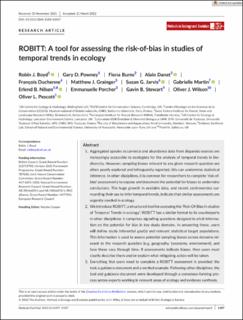ROBITT : a tool for assessing the risk-of-bias in studies of temporal trends in ecology
Boyd, Robin J.; Powney, Gary D.; Burns, Fiona; Danet, Alain; Duchenne, François; Grainger, Matthew J.; Jarvis, Susan G.; Martin, Gabrielle; Nilsen, Erlend Birkeland; Porcher, Emmanuelle; Stewart, Gavin B.; Wilson, Oliver J.; Pescott, Oliver L.
Peer reviewed, Journal article
Published version

Åpne
Permanent lenke
https://hdl.handle.net/11250/3005740Utgivelsesdato
2022Metadata
Vis full innførselSamlinger
Originalversjon
Boyd, R. J., Powney, G. D., Burns, F., Danet, A., Duchenne, F., Grainger, M. J., Jarvis, S. G., Martin, G., Nilsen, E. B., Porcher, E., Stewart, G. B., Wilson, O. J. & Pescott, O. L. (2022). ROBITT: A tool for assessing the risk-of- bias in studies of temporal trends in ecology. Methods in Ecology and Evolution, 13(7), 1497–1507. doi: 10.1111/2041-210X.13857Sammendrag
1. Aggregated species occurrence and abundance data from disparate sources are increasingly accessible to ecologists for the analysis of temporal trends in biodiversity. However, sampling biases relevant to any given research question are often poorly explored and infrequently reported; this can undermine statistical inference. In other disciplines, it is common for researchers to complete “risk-of-bias” assessments to expose and document the potential for biases to undermine conclusions. The huge growth in available data, and recent controversies surrounding their use to infer temporal trends, indicate that similar assessments are urgently needed in ecology. 2. We introduce ROBITT, a structured tool for assessing the “Risk-Of-Bias In studies of Temporal Trends in ecology”. ROBITT has a similar format to its counterparts in other disciplines: it comprises signalling questions designed to elicit information on the potential for bias in key study domains. In answering these, users will define study inferential goal(s) and relevant statistical target populations. This information is used to assess potential sampling biases across domains relevant to the research question (e.g. geography, taxonomy, environment), and how these vary through time. If assessments indicate biases, then usersmust clearly describe them and/or explain what mitigating action will be taken.3. Everything that users need to complete a ROBITT assessment is provided: the tool,a guidance document,and a worked example. Following other disciplines, the tool and guidance document were developed through a consensus-forming process across experts working in relevant areas of ecology and evidence synthesis.4. We propose that researchers should be strongly encouraged to include a ROBITT assessment when publishing studies of biodiversitytrends, especially when usingaggregated data. This will help researchers to structure their thinking, clearly acknowledge potential sampling issues,highlight where expert consultation is required, and provides an opportunity to describe data checks that might gounreported. ROBITT will also enable reviewers, editors, and readers to establish how well research conclusions are supported given a dataset combined with some analytical approach. In turn, itshouldstrengthen evidence-based policy and practice, reduce differing interpretations of data, and provide a clearer picture of the uncertainties associated with our understanding of reality. risk-of-bias; speciesoccurrence data; temporal trends; Essential Biodiversity Variables; indicators; uncertainty; insect declines
